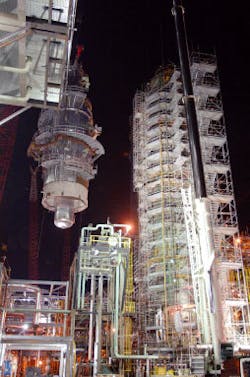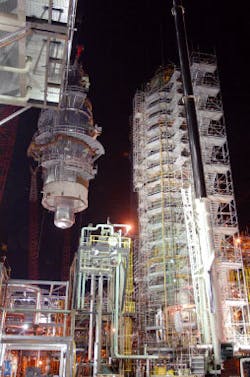Construction remains brisk in the processing and transportation segments of the global oil and gas industry.
Oil & Gas Journal’s Worldwide Construction Update reports the activity by specific project in the categories of refining, petrochemicals, gas processing, sulfur recovery, pipelines, LNG, and gas-to-liquids.
Compared with the previous edition of the semiannual update, the current report shows a large increase in the number of plans for new LNG facilities as well as for expansions of existing liquefaction plants and regasification terminals (OGJ, Nov. 21, 2005, p. 18).
Information for the report comes from a survey of facility operators as well as engineering and construction firms. Specific projects mentioned here are samples from a much larger list accessible to subscribers online (see box at left).
Refining
Among refining projects listed for the first time in this edition of the Worldwide Construction Update are a number of hydrotreater and crude distillation unit projects. Of all the projects detailed in the refining section of the survey, hydrotreaters dominate.
Click here to view Construction survey in PDF
Many refineries are undergoing expansions, and plans have been announced for new refineries in Asia, Africa, South America, and the Middle East. No new refineries are planned for North America, although heavy oil upgraders in Alberta are being built and expanded.
Husky Energy Inc. is in the detailed engineering stage of a project to expand the capacity of its Lloydminster upgrader to 150,000 b/d from 80,000 b/d. This expansion anticipates increased production from the company’s Tucker oil sands project at Cold Lake, Alta.
Meanwhile, CEPSA Group (Compañía Española de Petróleos SA) plans a major expansion of its La Rabida refinery in Huelva, Spain, with UOP LLC technology to be installed in eight process units.
With crude distillation capacity of 100,000 b/d, the La Rabida refinery has run at about 98% of capacity recently. The expansion plans call for increasing capacity by 90,000 b/d with a new crude distillation unit. Also planned are a 25,000 b/d vacuum distillation unit and a 32,000 b/d gas concentration unit, along with other units.
Marathon Oil Corp. late last year completed its Detroit refinery’s $300 million expansion and clean fuels project. The expansion increased capacity to 100,000 b/d from 74,000 b/d, providing more than 23,000 b/d of additional fuels to the Detroit market.
Completion of the clean fuels project allows the Detroit refinery to produce the low-sulfur gasoline and ultralow-sulfur diesel fuel required in the US this year.
Petrochemicals
Asia and the Middle East lead the world in current petrochemical projects, with plans for new and expanded facilities to produce polyethylene, polypropylene, polystyrene, methanol, and ethylene.
Dow Chemical Co. is performing engineering for a new ethylene plant in Sohar, Oman. The planned 850,000 tonne/year (tpy) plant will be completed in 2009 at an expected cost of $4 billion.
In Germany, BP PLC is in engineering stages of a 90,000 tpy expansion of its ethylene plant in Gelsenkirchen. And in the Netherlands, Saudi Basic Industries Corp. is performing engineering for a large expansion of its ethylene plant in Geleen.
Additional ethylene projects are planned in Venezuela, Saudi Arabia, Thailand, and South Korea, as well as other locations.
LNG, gas processing
Construction of LNG facilities is under way worldwide. Liquefaction plants are planned and under construction in China, Equatorial Guinea, Indonesia, Qatar, and elsewhere. Meanwhile, receiving terminals are planned or under construction in Canada, the US, the UK, Japan, and other locations.
Among the gas processing complexes planned, one of the most recently announced will be in Angola. Last month, Cabinda Gulf Oil Co. Ltd., a wholly owned Chevron Corp. subsidiary, awarded Chicago Bridge & Iron Co. (CB&I) a lump-sum contract to provide a gas processing and treating complex in Cabinda, Angola. The project is valued at $250 million.
CB&I’s work involves engineering, procurement, fabrication, and construction of facilities for gas and oil separation, vapor compression, amine treating for acid-gas removal, glycol dehydration, refrigeration for NGL recovery, molecular-sieve dehydration of hydrocarbon liquids, and liquids fractionation to produce NGLs for export and local consumption. Residual gas will feed three turbines for electricity generation. Completion of the project is planned for summer 2008.
Gas-to-liquids
There are plans for a handful of gas-to-liquids plants around the world, predominantly in countries where stranded gas is plentiful.
In Qatar, three GTL plants are in different stages of development.
The first project, operated by Oryx GTL Ltd., is to be completed soon and will produce 34,000 b/d of clean fuel. Oryx GTL is a joint venture of Qatar Petroleum and Sasol.
The second GTL project in Qatar is in the engineering stage. Part of Qatar Petroleum’s Pearl GTL project with Qatar Shell GTL Ltd. will produce 140,000 b/d of GTL products as well as condensate and LPG, with production beginning in 2010.
Meanwhile, the Qatar Petroleum GTL Ltd. project with ExxonMobil Corp. will become the world’s largest single fully integrated GTL project, producing 154,000 b/d of GTL products. This project is on schedule for a 2011 start-up and is still in the planning stages.
Sulfur
While most of the sulfur projects in the OGJ survey are for the construction of new recovery units, some are expansions or revamps of existing units.
In the US, plans call for the installation of a Claus sulfur recovery unit at Motiva’s Port Arthur, Tex., refinery and the revamp of the same type of unit at ConocoPhillips’s Ponca City, Okla., refinery. BP, Premcor Inc., and Valero Energy Corp. also are installing sulfur recovery units this year to comply with new fuel specifications.
Similar projects are in engineering or construction stages in Argentina, Belarus, China, Iran, and other locations.
Pipelines
Last month Norsk Hydro AS announced that a pipelay vessel restarted work on the Langeled gas pipeline 33 km from its origin at Nyhamna, Norway, where the project began last year, southwesterly toward Sleipner gas and condensate field in the Norwegian North Sea.
Pipelay for the southern segment of the 771-mile gas line was completed in November 2005 (OGJ, Feb. 13, 2006, p. 57).
Pipelaying northeasterly from Sleipner will start in August, and it is expected to be completed in November. The two pipeline ends will be welded together in 2007.
Between Sleipner and Easington, UK, the Langeled pipeline has a diameter of 44 in., and between Nyhamna and Sleipner, 42 in.
Norsk Hydro is the operator of Ormen Lange gas and condensate field and the Langeled line but delegated project management responsibility of Langeled to Statoil ASA. After Sept. 1, the Langeled operator will be Gassco AS, Norway’s wholly state-owned limited company that operates all gas transport from the Norwegian continental shelf. ✦



